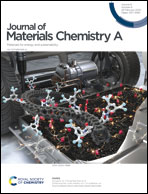Effect of conjugated polymer electrolytes with diverse acid derivatives as a cathode buffer layer on photovoltaic properties†
Abstract
We fabricated and tested inverted polymer solar cells (PSCs) that use a blend of PTB7-Th and PC71BM as the active layer and poly[(9,9-bis(3′-(N,N-dimethylamino)propyl)-2,7-fluorene)-alt-2,7-(9,9-dihexylfluorene)] (PFN) with different amounts and types of acid derivatives as the cathode buffer layer to systematically study the effect of amounts and types of acid additives such as acetic acid (AA), 4-trifluoromethyl benzoic acid (CF3BA), trifluoroacetic acid (CF3AA), and 4-toluene sulfonic acid (TsOH) on the device performances. Consequently, a significant improvement was obtained for the device based on ZnO/PFN with 1.0 equivalent (eq.) of acid derivatives. The PCE of the device with 1.0 equivalent of AA, CF3BA, CF3AA, and TsOH was 9.9, 10.3, 10.3, and 10.6% respectively, whereas the power conversion efficiency (PCE) of the device with pristine ZnO was 8.7%. The performances of the devices followed the trend of the acid dissociation constant of acid derivatives. In addition, we discovered that the most effective acid derivative is TsOH. Furthermore, we observed that the devices based on PFN with acid derivatives exhibited reduced trap-assisted recombination and interfacial bimolecular recombination. Furthermore, reduced trap-assisted recombination of the devices agreed well with the trend of the PCEs of PSCs and followed the trend of the acid dissociation constant of acid derivatives.



 Please wait while we load your content...
Please wait while we load your content...